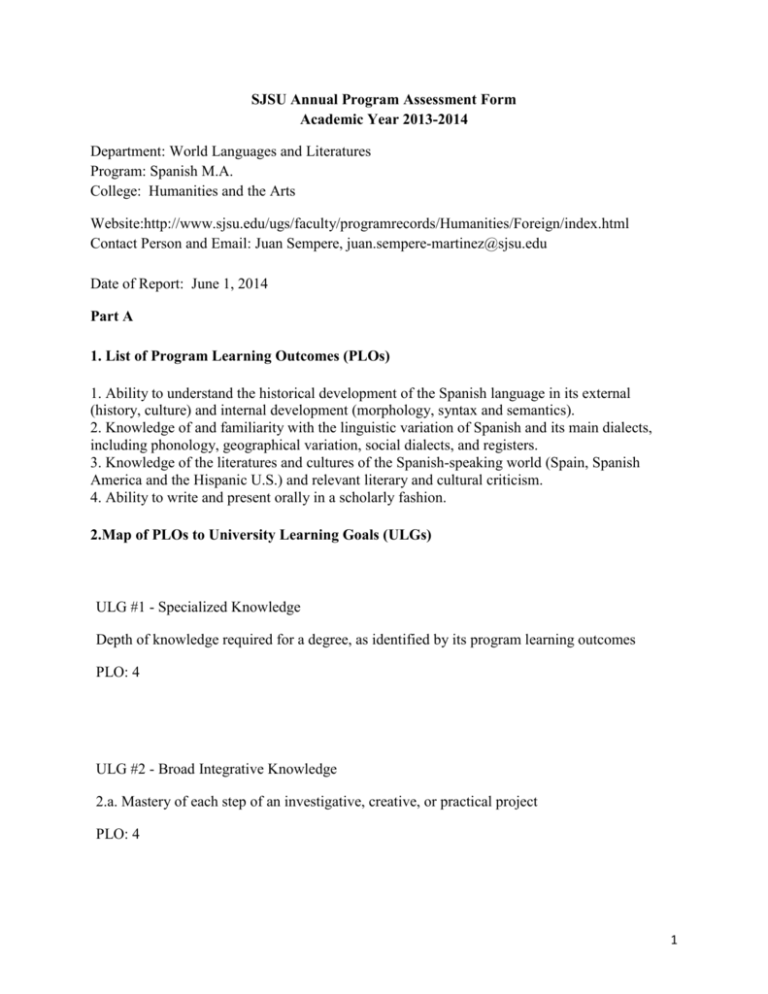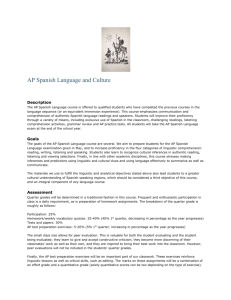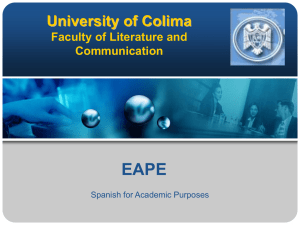AY 2013-2014 (doc)
advertisement

SJSU Annual Program Assessment Form Academic Year 2013-2014 Department: World Languages and Literatures Program: Spanish M.A. College: Humanities and the Arts Website:http://www.sjsu.edu/ugs/faculty/programrecords/Humanities/Foreign/index.html Contact Person and Email: Juan Sempere, juan.sempere-martinez@sjsu.edu Date of Report: June 1, 2014 Part A 1. List of Program Learning Outcomes (PLOs) 1. Ability to understand the historical development of the Spanish language in its external (history, culture) and internal development (morphology, syntax and semantics). 2. Knowledge of and familiarity with the linguistic variation of Spanish and its main dialects, including phonology, geographical variation, social dialects, and registers. 3. Knowledge of the literatures and cultures of the Spanish-speaking world (Spain, Spanish America and the Hispanic U.S.) and relevant literary and cultural criticism. 4. Ability to write and present orally in a scholarly fashion. 2.Map of PLOs to University Learning Goals (ULGs) ULG #1 - Specialized Knowledge Depth of knowledge required for a degree, as identified by its program learning outcomes PLO: 4 ULG #2 - Broad Integrative Knowledge 2.a. Mastery of each step of an investigative, creative, or practical project PLO: 4 1 2.b. Understanding of the implications of results or findings from a particular work in societal context PLO: 3 ULG #3 - Intellectual Skills 3.a. Fluency in the use of specific theories, tools, technology, and graphical representation PLO: 4 3.b. Skills and abilities necessary for life-long learning: critical and creative thinking effective communication, information gathering and processing, mastery of quantiative methodologies, and the ability to engage effectively in collabo PLOS: 1,2,3 ULG #4 - Applied Knowledge 4.a. Ability to integrate theory, practice, and problem-solving to address practical issues PLO: 1 3.Alignment – Matrix of PLOs to Courses 1. Ability to understand the historical development of the Spanish language in its external (history, culture) and internal development (morphology, syntax and semantics). SPAN 210, 220 2. Knowledge of and familiarity with the linguistic variation of Spanish and its main dialects, including phonology, geographical variation, social dialects, and registers. SPAN 225 2 3. Knowledge of the literatures and cultures of the Spanish-speaking world (Spain, Spanish America and the Hispanic U.S.) and relevant literary and cultural criticism. SPAN 250, 260, 270, 280, 202 4. Ability to write and present orally in a scholarly fashion. SPAN 250, 260, 270, 280, 202 4. Planning – Assessment Schedule Fall 2014 MA LEARNING OBJECTIVE 3: Knowledge of the literatures and cultures of the Spanishspeaking world (Spain, Spanish America and the Hispanic U.S.) and relevant literary and cultural criticism. SPAN 250 Spring 2015 MA LEARNING OBJECTIVE 2: Knowledge of and familiarity with the linguistic variation of Spanish and its main dialects, including phonology, geographical variation, social dialects, and registers. SPAN 225. Fall 2015 MA LEARNING OBJECTIVE 1: Ability to understand the historical development of the Spanish language in its external (history, culture) and internal development (morphology, syntax and semantics). SPAN 220 5. Student Experience Department: http://www.sjsu.edu/wll/programs/objectives Spanish M.A.: http://www.sjsu.edu/wll/programs/graduate/spanishma/ 3 Our meetings and analysis of PLOs allowed us to reach consensus about the PLOs and, in preparation for the WASC Road to 2014 reports, we again reviewed the proposed changes. In the spring of 2012 we assessed the new graduate PLO #3 “Knowledge of the literatures and cultures of the Spanish-speaking world (Spain, Spanish America and the Hispanic U.S.) and relevant literary and cultural criticism” in SPAN 202. Now, in the spring of 2014, SPAN 202, has been assessed once more, but this time for PLO #4. Part B 6. Graduation Rates for Total, Non URM and URM students (per program and degree) 6 Note: URM = African-American, Hispanic, and Americam-Indians; Non-URM = White and Asian/Pacific Islander; Other = Other and Foreign Academic Programs World Langs and Literatures First-time Freshmen: 6 Year Graduation Rates New UG Transfers: 3 Year Graduation Rates Grads : 3 Year Graduation Rates Fall 2007 Cohort Fall 2010 Cohort Fall 2010 Cohort Entering % Grad Entering % Grad Entering % Grad Total 18 55.6% 13 46.2% 15 60.0% URM 4 50.0% 5 40.0% 5 60.0% Non-URM 12 58.3% 4 50.0% 8 50.0% Other 2 50.0% 4 50.0% 2 100.0% 7. Headcount of Program Majors and New Students by Programs and Degree Note: 1st Fr. = First-time Freshmen; Transf = Transfer Students; UGs = Undergraduate Students; Creds = Credential Students; Grads = Gradua Fall 2013 4 New Students World Languages and Literatures Cont. Stud 1st Fr. UG Transf New Creds 1st Grads UGs Creds Total 9 18 0 10 114 0 BA 9 18 0 0 114 0 MA 0 0 0 10 0 0 Degree 8. SFR (Exhibit 3) and Average Headcount per Section (Exhibit 2) by Course Prefix Fall 2013 Student to Faculty Ratio (SFR) Average Headcount per Section Total 19.1 20.0 Lower Division 18.7 21.0 Upper Division 20.1 21.4 Graduate Division 17.1 14.8 Course Prefix Course Level SPAN - Spanish 9. Percentage of Full-time Equivalent Faculty (FTEF) for tenured/tenure-track instructional faculty by De Fall 2013 World Languages & Literatures % Tenured/Prob Tenured Temp Lecturer Probationary 68.0% 9.354 4.88 1.001 Part C 10. Closing the Loop/Recommended Actions 5 SPAN 202 and 250 have a set of rubrics and a description of how students were rated on PLO # 4 (Ability to write and present orally in a scholarly fashion). Similar rubrics exist for other courses as well. Also, some courses like SPAN 201, 210, 220 and 225 apply a triad of assessment procedures: diagnostic, formative and summative. A combination of these actions may be recommended for all courses. 11. Assessment Data SPAN 225 Fall 2012 PLO 2: Knowledge of and familiarity with the linguistic variation of Spanish and its main dialects, including phonology, geographical variation, social dialects, and registers A test/questionnaire to assess how students perceive dialectal variations was given to students on the second week of classes. The focus was on acoustic perception of geographical and social differences in pronunciation. The questionnaire was divided into two areas: (1) Comprehension of the variants and (2) the impression on the speaker as to which dialect was being played and the sociolinguistic status of the speakers. The results showed that while students were generally able to recognize dialects, they had difficulties pinpointing the specific linguistic features characterizing each dialect. -----------------------------------------------SPAN 220 Spring 2013 PLO 1: Ability to understand the historical development of the Spanish language in its external (history, culture) and internal development (morphology, syntax and semantics) Since a prerequisite for this class is SPAN 105, a test/questionnaire with data pertaining to basic historical Spanish linguistics was given to students on the second week of classes. The focus was on morphosyntactic rules, as well on the principal phonological developments from Latin into Spanish. Questions on the external history of the language were also inserted. Thus the questionnaire was divided into two main areas: (1) Knowledge of phonological and morphosyntactic rules and their application in similar phonological environments, albeit with some variations that had to be inferred by the student. (2) Knowledge of the sociolinguistic and historical variables in the formation of Spanish as it derived from Vulgar Latin. The results varied depending on the students’ background. Students who had completed their prerequisite at SJSU (80 %) scored within the “very good or A” level range (65 %) and “good or B” (15 %), etc. Students coming from other systems (20%) scored at different ranges: 10 % “deficient or D”, 5% “adequate or C” and 5% “very good or A”. 6 -------------------------------------------------SPAN 250 Fall 2013 PLO 4: Ability to present in Spanish in a scholarly fashion 1. SCOPE OF THE ASSESSMENT: In Fall 2012, the instructor for Spanish 250 (Graduate Seminar on Don Quijote) conducted an assessment of student’s ability to present in a scholarly fashion. A total of 25 student oral presentations were assessed utilizing a rubric and individual scores were aggregated to develop a composite report that reflects overall student performance. 2. 3. ASSESSMENT INSTRUMENT: The rubric measures the quality of student presentations in areas listed below and assigned them a rating: Introduction Organization Content Linguistic Competence Style and Delivery Quality of Presentation Aids Summary Educational Value -----------------------------------------------SPAN 202 Spring 2014 PLO 4. Ability to write and present orally in a scholarly fashion As part of the course, each student was asked to present on one of the assigned readings for the class, either from a primary or secondary (critical/scholarly) source. The guidelines for the presentation were posted on the class Canvas site, and were reviewed in class. The presentation was to be written and distributed in class. Finally, the students were provided with a rubric detailing the grading criteria. In particular, the students were to distinguish between primary and secondary sources, provide a summary of the main points of the reading, to offer 3-4 representative quotations from the text as well as four questions to foment discussion. In the case of a scholarly/critical text, the presenter was to identify the thesis and supporting arguments, as well as provide a critical judgment based on the strength of evidence the author provided in support of his/her argument. The students were then provided feedback based on the rubric criteria. ----------------------------------12. Analysis 7 SPAN 225 Fall 2012 PLO 2: Knowledge of and familiarity with the linguistic variation of Spanish and its main dialects, including phonology, geographical variation, social dialects, and registers Essays addressing the aforementioned issues demonstrated improvement and an adequate grasp in the response to phonetic texts on the part of most students. Most importantly, students are now able to evaluate data on dialects without the previous bias they had, when they started the course, as to what constitutes the language as opposed to its dialects. -----------------------------------SPAN 220 Spring 2013 PLO 1: Ability to understand the historical development of the Spanish language in its external (history, culture) and internal development (morphology, syntax and semantics) Homework, projects and the final exam showed considerable improvement and in many instances mastery of the phonological rules in the development of Latin into Spanish and a solid knowledge of sociopolitical variables in the external history of the language. 40% of the student achieved the “very good” ranking, 58% scored in the “good” category and 2 % failed to complete the course satisfactorily. -----------------------------------SPAN 250 Fall 2013 PLO 4: Ability to present in Spanish in a scholarly fashion 4. ASSESSMENT RESULTS: After each student presentation was assigned a rating of EXCELLENT, VERY GOOD, GOOD OR INADEQUATE in each of the categories listed above, the scores were tabulated and aggregated. -------------------------------------------SPAN 202 Spring 2014 PLO 4. Ability to write and present orally in a scholarly fashion The instructor noticed a high degree of difficulty in distinguishing primary from secondary sources (approx. 70% were showed evidence of misunderstanding in their presentations) and in the case of scholarly/critical works, approximately 60% either misidentified the thesis or confused it with the work's theme. 8 13. Proposed changes and goals (if any) SPAN 225 Fall 2012 PLO 2: Knowledge of and familiarity with the linguistic variation of Spanish and its main dialects, including phonology, geographical variation, social dialects, and registers The reader needs to be modified to include new impressionistic passages of linguistic texts as well as phonological passages. But the most significant modification will take effect during the firs three meetings. Then a crash course on sociolinguistics issues and on phonetics and phonology should be given so that those students lacking the necessary background will be able to better understand the course. -----------------------------------------SPAN 220 Spring 2013 PLO 1: Ability to understand the historical development of the Spanish language in its external (history, culture) and internal development (morphology, syntax and semantics) The proposed changes learned from assessment in this course would be that students at this level may need not only a solid foundation in an introductory course on linguistics, but also a full semester of Spanish phonetics and phonology at the undergraduate level. ------------------------------------------------SPAN 250 Fall 2013 PLO 4: Ability to present in Spanish in a scholarly fashion None ------------------------------------------------SPAN 202 Spring 2014 PLO 4. Ability to present in Spanish in a scholarly fashion In future sections the suggestion is to add a quiz question connected with each reading asking the students to identify a) whether the text is a primary or secondary source and b) in the case of a secondary source to identify the thesis statement. 9 10








